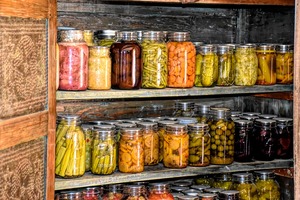Root cellar and pantry
Cooling cabinet or pantry
You design a pantry for long-term storage of food and beverages in larger quantities than is otherwise possible in your kitchen. It is especially interesting for those who grow a large part of the fruit or vegetables the family eats during the winter season. Finally, the obvious advantage of a virtual room is that you can arrange it solely for the purpose of food storage.

If you want to create a pantry in your home yourself, you must remember four basic rules. The room must not have windows; it should preferably face north, well-insulated walls – not only facing the garden, but also towards the other rooms of the house to avoid heat exchange – and good ventilation.
The most optimal is to establish a valve or limb, which you can adjust according to the weather. For example, in the summer it is best to have it completely closed in the heat during the day, but open in the cooler night air
Make the room by being dark and cool – but frost-free. Furthermore, you should secure it against mice and rats. Place the room so you can maintain a stable temperature during the winter months – between 5 and 10 degrees. This is the optimum temperature for food that does not necessarily need to be refrigerated or frozen. This relative coolness slows down bacterial growth and other biological degradation processes and allows the durability of a wide range of food.
In addition, the space should hold a humidity percentage of around 90, as it prevents drying of vegetables, root vegetables and onions.
Nature can become your new refrigerator
Save electricity as well as CO2 by cooling your vegetables, fruit, juice and jam with the help of nature.
If you dig approx. 1 meter into the ground, there is a temperature of 7-8 degrees all year round.
Outside pantry
You bury a meter in the ground on an area of three m2, and then lay a layer of seashells or pebbles as insulation at the bottom. Then cast a floor of concrete. You build walls up to man-height with brick and insulate the top.
Coolness utilizes cold from the ground because you have buried the cabinet below 90 cm. You maintain that temperature by creating circulation in the room by making a pipe that goes into the ground and comes up through a chimney with a built-in grate.
Make sure you place your pantry in the shade, with the door against north, allowing as little sunlight, and heat as possible, when you steps in to the pantry.
Make a root cellar
A root cellar is slightly larger and can protect fruits and vegetables from frost in winter, while keeping it cool in summer.
When deciding to build a root cellar, there are many factors to consider. First, consider where you want to place it.

If you have a slope to dig into it is perfect, otherwise, you have to dig down the root cellar. It is important that it be above ground level to avoid flooding. You allso lay a drainage layer in the floor so that there is no water
You will need to dig a 150 cm deep hole at 4 x 8 meters, and wall it up with stones at the sides and bottom. You can wall the sides 50 cm higher up and close the basement at the top with a slanted door. You must establish two holes with meshes in each of the gables – to ensure ventilation and keep animals out.
You can use the cellar all year round for storage of juice, wine, beer, jam etc., as a good cellar in the summer usually stays below 15 °. For storage of fruits and vegetables during the winter months, it must be 100% frost-free with a temperature between 0–4 ° C and a relative humidity of 97–99%. It is best to have a lock so you not let the outside air in directly.
Flat roof increases the risk of condensation water dripping onto the stored crops. A curved roof is better. You do not have to insulate against moisture, as there must be almost 100% moisture. To save the soil layer above the soil cellar, you can insulate the part of the cellar that is above ground
The ventilation must be good. In the winter, the fresh air must be warmed by the soil and in the summer, it must be cooled down by the soil. You can achieve this by passing the fresh air into the basement through a 20–25 m long pipe, which is buried in the ground at a depth of 1 m. Place the ventilation vent in the ceiling.
For some plans you can look at this site.